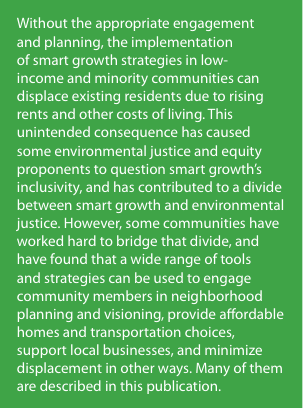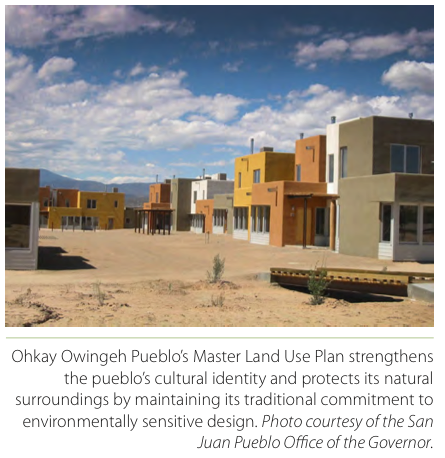ENVIRONMENTAL PROTECTION AGENCY
Chapter 1: Introduction
 Communities across the country are integrating smart growth, environmental justice, and equitable development approaches to design and build healthy, sustainable, and inclusive neighborhoods. Residents of Spartanburg, South Carolina, partnered with the local government, federal agencies, and industry stakeholders to create new housing, parks, businesses, and health clinics where brownfields, landfills, and abandoned buildings once existed. In New Orleans’ Versailles neighborhood, the community came together after Hurricane Katrina to rebuild its main business corridor and strengthen the neighborhood’s sense of place, which is anchored in Vietnamese culture. On the Ohkay Owingeh reservation in New Mexico, tribal leaders are implementing a Master Land Use Plan that creates affordable housing, preserves valuable water resources, and revives traditional Pueblo settlement patterns and historic plazas. Bethel New Life, a faith- based community development corporation on Chicago’s West Side, formed a regional coalition to preserve transit service in the predominantly African-American neighborhood and led the construction of shops, child care facilities, an employment center, and energy-efficient and affordable homes around a train station.
Communities across the country are integrating smart growth, environmental justice, and equitable development approaches to design and build healthy, sustainable, and inclusive neighborhoods. Residents of Spartanburg, South Carolina, partnered with the local government, federal agencies, and industry stakeholders to create new housing, parks, businesses, and health clinics where brownfields, landfills, and abandoned buildings once existed. In New Orleans’ Versailles neighborhood, the community came together after Hurricane Katrina to rebuild its main business corridor and strengthen the neighborhood’s sense of place, which is anchored in Vietnamese culture. On the Ohkay Owingeh reservation in New Mexico, tribal leaders are implementing a Master Land Use Plan that creates affordable housing, preserves valuable water resources, and revives traditional Pueblo settlement patterns and historic plazas. Bethel New Life, a faith- based community development corporation on Chicago’s West Side, formed a regional coalition to preserve transit service in the predominantly African-American neighborhood and led the construction of shops, child care facilities, an employment center, and energy-efficient and affordable homes around a train station.
These diverse communities and many others are finding that environmental justice, smart growth, and equitable development can be an effective combination for promoting a clean and safe environment, a strong economy, and good quality of life for all residents. Overburdened communities are using smart growth strategies to address long-standing environmental and health challenges and create new opportunities where they live. Regional and local planners are engaging low-income, minority, and tribal residents in decision-making and producing more enduring development that is better for people and the environment. Community groups, government agencies, and private and nonprofit partners are cleaning up and investing in existing neighborhoods, providing affordable housing and transportation options, and improving access to critical services and amenities.
 This informational publication aims to build on the successes described above and help other low-income, minority, tribal, and overburdened communities shape development that responds to their needs and reflects their values. It identifies approaches that bring together smart growth, environmental justice, and equitable development principles and can be used by community-based organizations, community development corporations, local and regional decision-makers, developers, and other stakeholders to build healthy, sustainable, and inclusive communities. These are places that provide clean air, water, and land; affordable and healthy homes; safe, reliable, and economical transportation options; and convenient access to jobs, schools, parks, shopping, and other daily necessities. This publication provides a menu of strategies and best practices for local policy-makers and community leaders to consider. Each community can choose the approaches that best suit its needs and goals.
This informational publication aims to build on the successes described above and help other low-income, minority, tribal, and overburdened communities shape development that responds to their needs and reflects their values. It identifies approaches that bring together smart growth, environmental justice, and equitable development principles and can be used by community-based organizations, community development corporations, local and regional decision-makers, developers, and other stakeholders to build healthy, sustainable, and inclusive communities. These are places that provide clean air, water, and land; affordable and healthy homes; safe, reliable, and economical transportation options; and convenient access to jobs, schools, parks, shopping, and other daily necessities. This publication provides a menu of strategies and best practices for local policy-makers and community leaders to consider. Each community can choose the approaches that best suit its needs and goals.
Core Concepts
Environmental justice, smart growth, and equitable development goals and principles have fundamental areas of overlap. They all aim to create communities that are healthy, environmentally sustainable, and economically vibrant. They also seek to empower residents to shape development where they live. This section introduces the three concepts. The strategies and approaches described later in the publication draw on these three fields.
Read full report (PDF) here: Creating Equitable, Healthy, and Sustainable Communities
About the US Environmental Protection Agency (EPA)
www.epa.gov
“The mission of EPA is to protect human health and the environment. EPA’s purpose is to ensure that: all Americans are protected from significant risks to human health and the environment where they live, learn and work; national efforts to reduce environmental risk are based on the best available scientific information; federal laws protecting human health and the environment are enforced fairly and effectively…”
Tags: Environmental Justice, Environmental Protection Agency, EPA, Equitable Development, Smart Growth, Sustainable Communities






 RSS Feed
RSS Feed